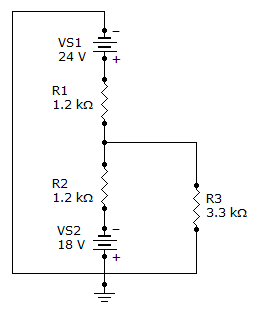Electrical Engineering - Circuit Theorems and Conversions - Discussion
Discussion Forum : Circuit Theorems and Conversions - General Questions (Q.No. 3)
3.
Find the total current through R3 in the given circuit.


Discussion:
40 comments Page 1 of 4.
Harsh Sharma said:
1 decade ago
If you want the answer by nodal analysis,
See that the 18 we source is coming in front of 24 we source because in between their path no element is connected.
So while writing kcl we have [ 24 - 18 ] = 6 we source above the 1.2k resistor.
By that you solve and will get the answer as 1.8 mA.
Answer can also be given by source transformation technique.
Try it once also interesting to analyse the circuit.
See that the 18 we source is coming in front of 24 we source because in between their path no element is connected.
So while writing kcl we have [ 24 - 18 ] = 6 we source above the 1.2k resistor.
By that you solve and will get the answer as 1.8 mA.
Answer can also be given by source transformation technique.
Try it once also interesting to analyse the circuit.
Adnan CECOSIAN said:
1 decade ago
Use mesh analysis:
Create two loops then apply KVL we get 2 equations
Loop1; (1.2k)(I1)+(1.2k)(I1+I2)=24
Loop2: (1.2k)(I2)+(1.2k)(I1+I2)=-18
Rearrange these two equations
then find Whole Deterimnent which i found
=4.32k^2
use cramer Rule
I1=18.35mA
and I2=16.6mA
now therefore current through 1.2kohm Resistor is
I1+I2=18.35-16.6
=1.75mA
So Answer D is correct.
Create two loops then apply KVL we get 2 equations
Loop1; (1.2k)(I1)+(1.2k)(I1+I2)=24
Loop2: (1.2k)(I2)+(1.2k)(I1+I2)=-18
Rearrange these two equations
then find Whole Deterimnent which i found
=4.32k^2
use cramer Rule
I1=18.35mA
and I2=16.6mA
now therefore current through 1.2kohm Resistor is
I1+I2=18.35-16.6
=1.75mA
So Answer D is correct.
Prabha said:
10 years ago
Superposition Theorem says:-
The total current in any part of a linear circuit equals the algebraic sum of the currents produced by each source separately.
To evaluate the separate currents to be combined, replace all other voltage sources by short circuits and all other current sources by open circuits.
By using this the answer is 5.5mA.
The total current in any part of a linear circuit equals the algebraic sum of the currents produced by each source separately.
To evaluate the separate currents to be combined, replace all other voltage sources by short circuits and all other current sources by open circuits.
By using this the answer is 5.5mA.
Beth Tate said:
1 decade ago
If you do the node analysis on this problem, you get your current to be .769 mA. By splitting the above circuit into two sections with 2 diffferent currents, you also get .769 mA. How do you come to get the answer 1.8 mA ?
(1)
Rituraj patra said:
8 years ago
The voltage across r3 is24-18 = 6, and current is 6/3.3=1.8.
Sanju said:
9 years ago
Let's consider a point of junction of r2 and r1 has a potential V2.
Then by KCL: ((24 - V2)/r1) = ((V2 - (-18))/r2) + ((V2 - (ground voltage 0V) )/ r3)
We get V2 = 3/38 volts,
and I through register is V2/r3 = 7.3 mA.
Then by KCL: ((24 - V2)/r1) = ((V2 - (-18))/r2) + ((V2 - (ground voltage 0V) )/ r3)
We get V2 = 3/38 volts,
and I through register is V2/r3 = 7.3 mA.
Jan said:
1 decade ago
Hi every one,
R2 and voltage source are connect ground potential.
Then I = V/R.
= 24/1.2+3.3 = 5.33 mA.
Why do you consider 18 volt source? That is open.
Please explain any one. Thanks advance.
R2 and voltage source are connect ground potential.
Then I = V/R.
= 24/1.2+3.3 = 5.33 mA.
Why do you consider 18 volt source? That is open.
Please explain any one. Thanks advance.
Satyajit said:
8 years ago
The voltage across the 3300-ohm resistor is 2.538 v, not 6 volt due to drop in 1200 ohm resistors.
By nodal analysis, superposition theorem, Thevenin's theorem I got the answer 0.000769amp
By nodal analysis, superposition theorem, Thevenin's theorem I got the answer 0.000769amp
(2)
Swallah Marani said:
9 years ago
Using superposition.
Current produced by 24V = 11.5A
Current produced by 18V = 8.7A
Resultant current ; 11.5- 8.7 =2.8
Current in R3 3.3 ; 2.8[1.2]/[1.2+3.3] = 0.75A#.
Current produced by 24V = 11.5A
Current produced by 18V = 8.7A
Resultant current ; 11.5- 8.7 =2.8
Current in R3 3.3 ; 2.8[1.2]/[1.2+3.3] = 0.75A#.
Jagadesh said:
10 years ago
As both the voltage sources are opposing in connection therefore the resultant voltage will be 24-18 = 6V.
The current through 3.3k resistor will be 6/3.3k = 1.8 mA.
The current through 3.3k resistor will be 6/3.3k = 1.8 mA.
Post your comments here:
Quick links
Quantitative Aptitude
Verbal (English)
Reasoning
Programming
Interview
Placement Papers